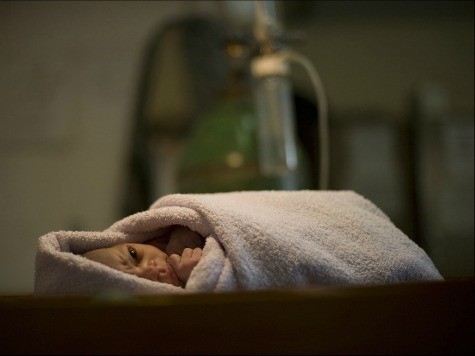
Following the decriminalization of abortion by Roe v. Wade in 1973, the brutality of abortion and the unsanitary conditions of abortion clinics have remained suppressed by the media. In fact, pro-life activist Nancy Creger says that what Kermit Gosnell has been doing at his clinic in Philadelphia, had been happening for years elsewhere.
In 1998, the Georgia Bulletin published a story about Midtown Hospital in Atlanta, which had been the subject of an investigation in 1983 after Creger exposed death certificates revealing that 14 babies had survived second trimester abortions in a three-year period at the facility.
The death certificates showed that the babies had lived for various amounts of time, ranging from 20 minutes to 13 hours, yet there was no indication that the infants were transported to the neonatal unit of a hospital that cares for premature babies. At the time, Midtown Hospital claimed that transporting a baby that survived abortion was a decision to be made by the attending physician.
According to the Bulletin, nine of the death certificates listed “hospital disposal” or “Midtown Hospital” under the category of “Cemetery or Crematory Name.”
“Midtown, I learned, specialized in late-term abortions, and advertised in newspapers up and down the East Coast,” writes Creger in LifeNews. She reports that after she was given copies of the death certificates, she decided to call CNN.
“I knew this was a huge scandal, and that CNN would give it national coverage,” Creger states. She relates that the CNN reporter was all set to go with filming the story, but then suddenly informed Creger that it had been cancelled.
“Someone at CNN wanted the story buried, just like today with the abortion doctor Kermit Gosnell story of the massacre of babies at his clinic,” Creger writes.
Creger states that she then teamed up with Father Noel Burtenshaw, who asked her to write her story. Burtenshaw interviewed regulatory affairs and health department officials. He and the staff at the Georgia Bulletin, the newspaper of the Archdiocese of Atlanta, published her discovery, and the story was out on television, in newspapers, and in national pro-life organizations.
“The relevant section of the Georgia Code in 1983 referred to the possibility of a baby surviving an abortion in the third trimester of pregnancy, and said if this happened medical aid must be rendered,” Creger writes. “There was no reference in the Code to a baby surviving a second trimester abortion.”
Creger states that interviews in 1983 with Department of Human Resources (DHR) officials revealed no clear rules for treating infants who had survived abortions. As a result of her expose, Midtown Hospital was asked by DHR to draft new guidelines for caring for surviving babies, though the decision as to how to handle a born-alive infant was ultimately left to the physician.
“Today, when asked about the Gosnell case, Planned Parenthood states that it’s up to a woman and her doctor,” comments Creger. She says, however, “the possibility of ‘live births’ at Midtown was being eliminated a year after her 1983 expose.
Creger writes that, in August of 1984, the Bulletin reported that an experimental procedure had been developed at Midtown Hospital in which an adult dosage of digoxin was injected directly into the heart of a five-month-old baby in the uterus, with the aim of killing the infant prior to abortion. Essentially, the injection would induce a massive heart attack in the baby.
The Bulletin indicates that, at the time, the administrator of Midtown Hospital refused to discuss the procedure or whether the women patients, whose unborn babies received digoxin injection abortions, were aware they were taking part of an experimental procedure or had given their consent.
Creger reports that she learned the abortion doctors at Midtown were going to Kansas to be instructed in the digoxin procedure by late-term abortionist George Tiller.
In May of 1998, Midtown Hospital was shut down, according to the Bulletin, after the state documented conditions at the abortion facility which “shocked inspectors and revealed women patients were being treated in unsanitary, overcrowded, poorly staffed and dangerous conditions.”
Affidavits filed by the state included reports from two patients and several former employees, in addition to those by DHR.
A 31 year-old patient said that, when she went for an abortion in February of 1998, conditions at Midtown “were so crowded that women were lying on the floor and on chairs after labor had been induced, screaming in pain without any monitoring by staff.” She reported that one woman gave birth in a bathroom that day.
The woman, who said that she was at Midtown from 6:00 a.m. until 9:00 p.m., stated in her affidavit that blood and urine were everywhere, and that staff stepped over patients who were lying on the floor.
Another woman who went to Midtown for an abortion in April of 1998, had to be admitted to a hospital several days later on an emergency basis. She was reportedly suffering from severe pain, bleeding, and vomiting. She was later diagnosed as having had an “incomplete abortion,” according to the affidavit, and ultimately required surgery.
The affidavit of a former Midtown employee indicated:
I routinely saw patients expel fetuses on the floor and in the commode in the preoperative room…I saw a fetus that had a foot as long as my hand. I saw another fetus with a full head of hair. Oftentimes, I was the only staff member in that area to assist the patients. I do not have medical training.
In seeking a court order to close down Midtown, the state indicated, “Midtown Hospital…continues to display a complete disregard for, or the inability to care for, the health and safety of its patients.” In addition, Midtown’s “continuing failure to meet minimum health and safety standards…places the health and safety of its patients in jeopardy on a daily basis.”

COMMENTS
Please let us know if you're having issues with commenting.